Strategi trading untuk mendukung pengambilan keputusan Anda
Temukan teknik praktis untuk membantu Anda merencanakan, menganalisis, dan meningkatkan trading Anda.


Most traders understand EA portfolio balance through the lens of traditional risk management — controlling position sizes, diversifying currency pairs, or limiting exposure per trade.
But in automated trading, balance is about deliberately constructing a portfolio where different strategies complement each other, measuring their collective performance, and actively managing the mix based on those measurements.
The goal is to create a “book” of EAs that can help diversify performance over time, even when individual strategies hit rough patches.
A diversified mix of EAs across timeframes and assets can, in some cases, reduce reliance on any single strategy. This approach reduces dependency on any single EA’s performance, smooths your overall equity curve, and builds resilience across changing market conditions.
It’s about running the right mix, identifying gaps in your coverage, and viewing your automated trading operation as an integrated whole rather than a collection of independent systems.
Basic Evaluation Metrics – Your Start Point
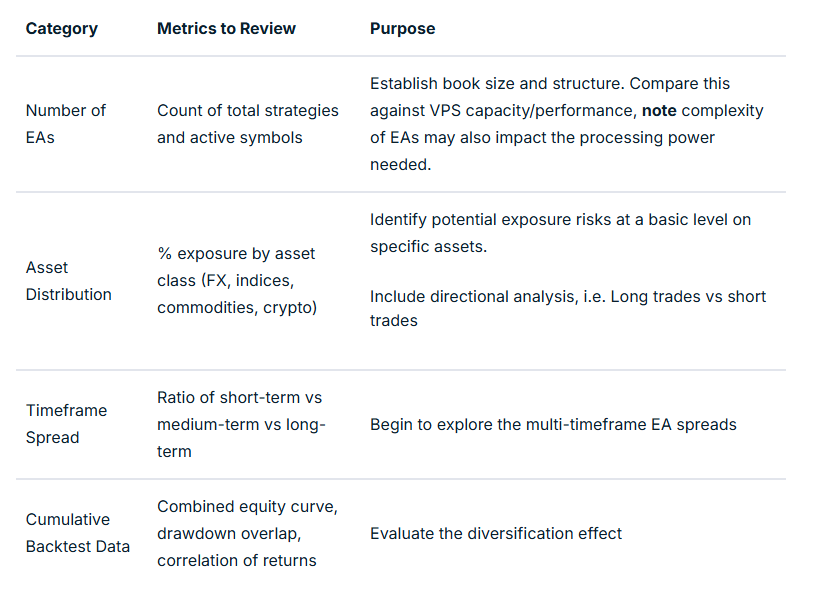
Temporal (timeframe) Balancing
When combined, a timeframe balance (even on the same model and instrument) can help flatten equity swings.
For example, a losing phase in a fast-acting M15 EA can often coincide with a profitable run in an H4 trend model.
Combining this with some market regime and sessional analysis can be beneficial.
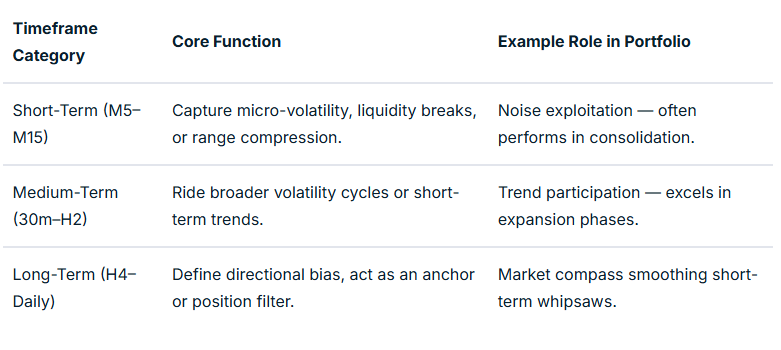
Asset Balance: Managing Systemic Correlation Risk
Running five different EAs on USDJPY might feel diversified if each uses different entry logic, even though they share the same systemic market driver.
But in an EA context, correlation measurement is not necessarily between prices, but between EA returns (equity changes) relating to specific strategies in specific market conditions.
Two EAs on the same symbol might use completely different logic and thus have near-zero correlation.
Conversely, two EAs on a different symbol may feel as though they should offer some balance, but if highly correlated in specific market conditions may not achieve your balancing aim.
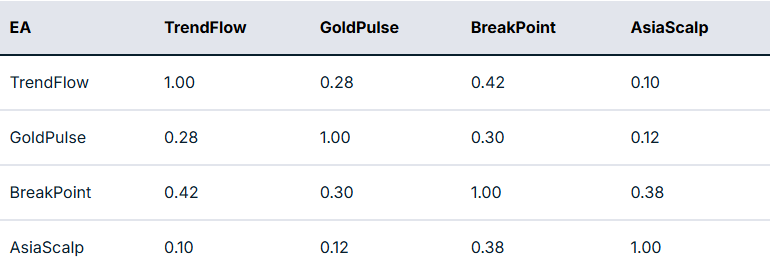
In practical terms, the next step is to take this measurement and map it to potential actionable interventions.
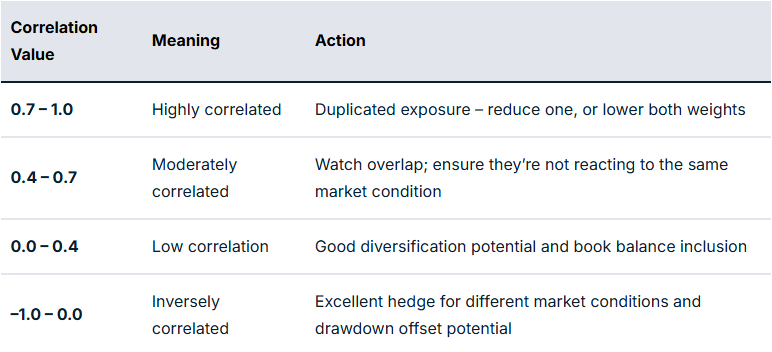
For example, if you have a EURUSD Trend EA and a GBPUSD Breakout EA with a correlation of 0.85, they are behaving like twins in performance related to specific market circumstances. And so you may want to limit exposure to some degree if you are finding that there are many relationships like this.
However, if your gold mean reversion EA correlates 0.25 compared to the rest of your book, this may offer some balance through reducing portfolio drawdown overlap.
Directional and Sentiment Balance
Markets are commonly described as risk-on or risk-off. This bias at any particular time is very likely to impact EA performance, dependent on how well balanced you are to deal with each scenario.
You may have heard the old market cliché of “up the staircase and down the elevator shaft” to describe how prices may move in alternative directions. It does appear that optimisation for each direction, rather than EAs that trade long and short, may offer better outcomes as two separate EAs rather than one catch-all.
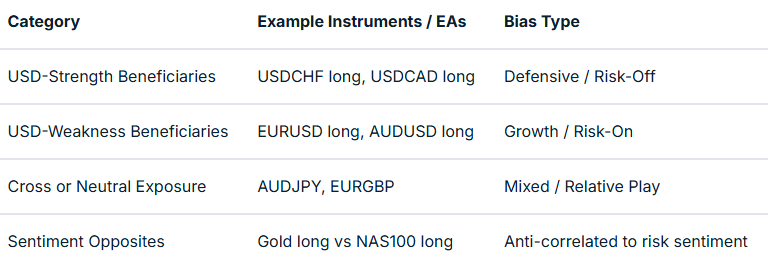
Market Regime and Volatility Balance
Trend and volatility states can have a profound impact on price action, whether as part of a discretionary or EA trading system. Much of this has a direct relationship to time of day, including the nature of individual sessions.
We have a market regime filter that incorporates trend and volatility factors in many EAs to account for this. This can be mapped and tested on a backtest and in a live environment to give evidence of strategy suitability for specific market conditions.
For example, mean reversion strategies may work well in the Asian session but less so in strongly trending markets and the higher volatility of the early part of the US session.
As part of balancing, you are asking questions as to whether you actually have EA strategies suited to different market regimes in place, or are you using these together to optimise book performance?
The table below summarises such an approach of regime vs market mapping:
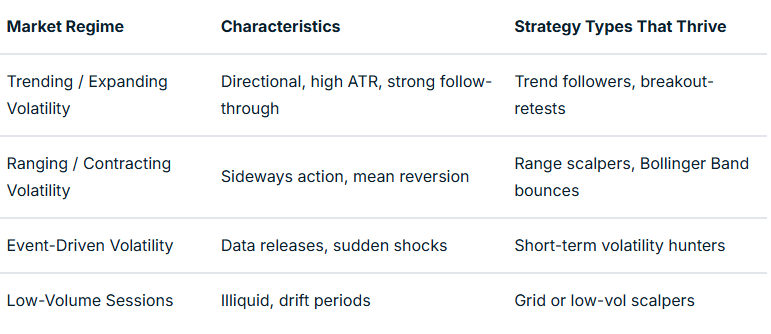
Multi-Level Analysis: From Composition to Interaction
Once your book is structured, the challenge is to turn it into something workable. An additional layer of refinement that turns theory and measurement into something meaningful in action is where any difference will be made.
This “closing the circle” is based on evidence and a true understanding of how your EAs are behaving together. It is the step that takes you to the point where automation can begin to move to the next level.
Mapping relationships with robust and detailed performance evaluation will take time to provide evidence that these are actually making a difference in meeting balancing aims.
To really excel, you should have systems in place that allow ongoing evaluation of the approaches you are using and advise of refinements that may improve things over time.
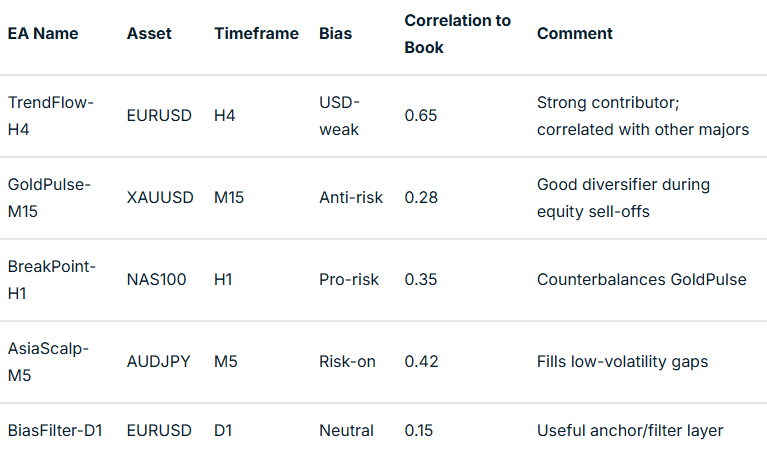
What Next? – Implementing Balance in Practice
Theory must ultimately translate into an executable EA book. A plan of action with landmarks to show progress and maintain motivation is crucial in this approach.
Defining classification tags, setting risk weights, and building monitoring dashboards are all worth consideration.
Advanced EA traders could also consider a supervisory ‘Sentinel’ EA, or ‘mothership’ approach, to enable or disable EAs dynamically based on underlying market metrics and external information integrated into EA coding decision-making.
Final Thoughts
A balanced EA portfolio is not generated by accident; it is well-thought-out, evidence-based and a continuously developing architecture. It is designed to offer improved risk management across your EA portfolio and improved trading outcomes.
Your process begins with mapping your existing strategies by number, asset, and timeframe, then expands into analysing correlations, directional bias, and volatility regimes.
When you reach the stage where one EA’s drawdown is another’s opportunity, you are no longer simply trading models but managing a system of EA systems. To finish, ask yourself the question, “Could this approach contribute to improved outcomes over time?”. If your answer is “yes,” then your mission is clear.
If you are interested in learning more about adding EAs to your trading toolbox, join the new GO EA Programme (coming soon) by contacting [email protected].


Corporate actions are activities that material effect an organisation and impacts the key stakeholders including shareholders and creditors. They can affect the stock price both in good and bad ways. Corporate actions are most often determined and voted on by the board of directors of the company.
Although sometimes, shareholder will be given the chance to either vote or participate in these actions such as placements. Why are they important? Corporate actions materially affect the share price are highly important to understand.
This means that the actual value of the company or the share price will change due to one of these actions. This also means that they can be great catalysts for volatile trade opportunities Examples of Common Corporate Actions Dividends Mature companies or companies who record consistent profits may issue dividends to their ordinary shareholders. It is important to understand what a dividend is.
It is a company distributing a share of its profits to give back to investors. This dividend is paid to investors and means that once the dividend has been returned the share price must be adjusted to reflect the reduction in future cashflow. Dividends may also be issued via a reissuing of shares or a reinvestment plan.
Stock Split A stock split is when a company decides to split each of its shares by a certain ratio for example 1:5 or 1:10. The reason that companies will split stocks are usually for liquidity purposes. When a company has small number of outstanding shares it often leads to low liquidity and volatile prices due to large spreads between the bid and ask prices.
Therefore, by splitting stocks the company can improve the liquidity of its share price. The results of this action will increase liquidity but also lower the share price and volatility of the security. Reverse stock split or consolidation The process of a stock consolidation is just the reverse of a stock split.
This occurs when a company’s share price is too low or is too easily manipulated because there are too many shares available to trade. It is also important to note that most exchanges have rules that will strike out company’s trading on their exchange if the share price drops too low. Therefore, a stock consolidation may occur may have to happen out of necessity.
Mergers and Acquisitions Mergers and acquisitions are probably the most complex corporate action to understand. They generally involve one company buying or taking over another company. This process can take some time and is not as generic as the other actions.
There are multiple ways in which the buying company can purchase the other company. It may involve payment of cash, debt, shares, option, or a combination of these and other financing options. Most often the company buying, will have to pay a premium to cover the goodwill from the company being acquired.
The initial bid therefore provides a valuation for the company being acquired. To further complicate matters, a bid especially an initial bid is not always the final offer which makes finding a fair value for the share price difficult and provides great opportunities for trading as the market tries to find the fair value. Rights Issuing or share placements Companies for a variety of reasons need to raise money.
They can do this by selling new shares to existing shareholders or even private institutions. This enables the company to increase its equity. At the same time this dilutes the shares outstanding which will most likely reduce the price of the company’s shares.
In addition, these placements or new issues are often prices that are already discounted to the price at the time of the placement. A company may raise capital for a variety of reasons which include, increasing cash at hand, dealing with liquidity problems, purchasing of new equipment, purchasing of another company. Share Buyback A share buyback is when a company decides to purchase its own shares from the float to reduce the number available for trade.
Companies may do this to either regain control of some of the shares or also to increase the value of their shares for its holders. Whilst it is a different mechanism it has a similar effect to a dividend. This is because as the company buys back the shares the supply reduces, and the purchasing of the shares increases the market price.
Corporate actions are an important part of the capital markets and as catalysts for price changes for shares. Therefore, traders should be aware of the different types of corporate actions and the effect they can have on the price of a company’s share price.


How to use Arbitrage trading to increase profits Professionals in finance like to use hard to read and complicated language to make what they do much harder and more complicated than it sounds. However, when it comes to arbitrage, it is actually a relatively simple concept that can be used in trading, to develop an accurate system that can be used in various markets. The Law of One Price In order to understand Arbitrage trading, a trader needs to understand the law of one price.
It states that the same goods sold in different markets in conditions, free of competition and expressed in the same currency, must be sold at the same price. Although this is an economic theory, the principles follow into financial markets. This means that in an efficient market, prices for the same asset cannot be different.
In practice, this is not always the case or rather it is not always the case straight away and his is where arbitrage opportunities exist as the market tries to move the prices into one. What is an Arbitrage? An arbitrage is when the law of one price has not yet been realized.
Essentially, the market is in the process of converging the prices. The best example is that of dual listed companies. These are companies who have shares listed on multiple exchanges.
Initially the price may be different due to exchange rates, different number of shares on issue. However, the relative value for each share must be the same. Usually, they are larger companies or multinational companies.
For instance, BHP is listed on both the ASX and the London Stock Exchange. The strategy can involve selling the shares on the exchange where it is more expensive and buying them back on the cheaper exchange or the alternative and profiting the difference. Other arbitrage opportunities can exist in companies that are primarily traded on an exchange but also have an over the counter, (OTC) listing.
These OTC listings are often much more illiquid allowing for more arbitrage opportunities Additionally, the primary market will usually be the lead pricing target, whilst the OTC or secondary market will attempt to move towards that price. Merged Arbitrage This strategy involved targeting companies that are in the process of being taken over or bought out. The acquirer will need to put an offer per share in order for a take-over to occur.
This gives the market a value for the shares. Generally speaking, the price will have to move towards the offer, especially if it is accepted. In a recent example, company Tassal formally TGR.AX, announced it was being bought out by a private equity firm.
There were previous offers made at $4.67, $4.80 and $4.85 per share before the final offer came at $5.25 a share. It can be seen from the price chart that the share price did not reach $5.25 immediately. The interesting thing to note here is that even though the final and accepted offer came in at $5.25 on the day of the announcement the price only reached $5.12 still $0.13 short of the offer.
This represented an arbitrage opportunity of $0.13 for savvy traders and investors. Although the actual % gain was not very high, the relative certainty of the price target made this trade a potential big winner. Opportunities like this are not always perfect and deals may not always follow through, but a skilled trader can develop a very strong system around this premise.
Overall, arbitrage trading may seem difficult but in reality, the theory is relatively straight forward. Finding mispricing within the market and capitalising on them can take some practice but they can also offer longer and shorter terms edges when the market is not providing other sufficient trading opportunities.


As a new trader, riding the emotional ups and downs can be a very difficult task. It is human nature to feel the pain of a losing trade. The losing often outweighs the positive feeling of any winning trade.
Dealing with the emotion of trading can be an incredibly difficult task. It can cause even the best system to fail. A trading journal especially early on in a trading journey can provide important feedback and information about the effectiveness of an edge.
The reality is that early on profit and loss can be terrible measure of an individual’s trading ability which is why a journal is so essential. There are many different formats and styles of journals that can be used. Some like to base their journal around a calendar.
Others like to pick out their best and worst trade each day and analyse them intensely. In the end, it doesn’t matter what style is chosen if a consistent structure is followed. Both quantitative and qualitative measures that ca be used to measure performance.
What to include in your journal? Below is a breakdown of elements that can be analysed in the trading journal. Initial trade idea – This is the overall basis of the trade, it can be related to a technical pattern, fundamental factor such as a news or a mix of both.
Some traders call this the trade hypothesis or thesis. In its most simple form, it is the very reason a trader enters into a trade. When journaling, it is important to evaluate the strength of the idea, whether it was correct and why or why not the trade was validated or invalidated.
It is also worth noting if the idea is a common one, such as news catalysts, repeating technical patterns. This can also be elevated by understanding how different trade ideas work together to create stronger overall trade ideas. Entry – Breaking down the key elements of the trade are important aspects to a journal.
More specifically outlining whether an entry was ideal, correct and managed well. Was the entry chased or was patience shown to achieve a more ideal entry. The entry is also a part of a trade with heightened emotion.
Therefore, journaling how emotions were managed and ways to improve emotional management is an important aspect of reviewing the entry. Exit – It goes without saying that the exit is the reciprocal of the entry and just as important. Analysing whether the exit was correct at both the time and in hindsight is an important step.
By continuously analysing both entries and exits, a trader will likely see an improvement in this aspect of their trading. In addition, they will potentially remove external factors such as emotion and noise from other influences such as twitter. Sizing – Sizing is an extremely tricky area of trading to master and there are many different theories on what sizing tactic is the best for each trade.
Some traders like to increase size depending on how strong a trade set up is whilst other like to have more consistent sizing strategies regardless of the strength of a trade. When reviewing it is important to make note of whether the sizing strategy worked. Trading with too much size can affect the active management of a trade as a trader can lose sight of the trade at hand and become too concerned about the potential outsizes loss.
Trade management – Whilst all the above can all constitute some level of trade management reviewing, analysing the whole management of the trade is vital. This can include the effectiveness in taking profits or losses and how the trader has dealt with their emotions. Management of fear and greed are the two most common emotions that a trader feels.
Grading – Having some quantitative measure even though it is subjective can help classify many trades over a long period of time. Using either letters or a number ranking can be just one method. This allows for a trader to identify their best performing trades and where the strongest edge is.
This list should not be seen as exhaustive, and traders can tinker and adjust to suit their own trading strategy. Reviewing the journal. It is important to review the journal at the end of a set time whether it be weekly or monthly to see if common mistakes are occurring or a theme is emerging.
If the same mistake keeps occurring, it may act as point of emphasis for future journaling or improvement. Ultimately, using a journal can accelerate the learning curve drastically especially for new traders.


The market in recent months has created exceptionally difficult conditions to trade. Low volatility and obscure price action has reduced the volatility available for traders to capitalise on. These conditions have affected FOREX, Equity, and Index trading.
It has been specifically difficult for momentum and trend following traders as a certain level of volatility is needed for trader to return profitable trades. How to spot low volatility The Average True range or ATR range can be an important indicator in determining the level of volatility in a market or asset. It measures the average trading range of a particular asset’s price over a period.
It can exceptionally be helpful in determining how volatile the asset is at a certain point in time, or how volatile an asset is compared to another one. For instance, looking at the ATR for the Dow Jones, it has been getting progressively lower and is at its lowest level since August indicating a reduction in volatility. The Market Volatility Index or the VIX measures volatility across the S&P 500 is also an important indicator to not just gauge market volatility, but also general market sentiment and emotion.
When fear and greed are prominent in the market volatility tends to increase and when they dissipate, they tend to decrease. As the chart shows, volatility has been reducing to levels not seen since the rally in August 2022. The characteristics of the chart are also interesting as the VIX acts much more in waves then other indices do.
How can you optimise your trading during periods of low volatility? Tips for trading in low volatility markets Understand that breakouts will fail. Specifically for traders who like to use strategies based on momentum breakouts, during times of low volatility the price means to stay close to moving averages and mean price points both on an intra and inter day level.
Wait for confirmation before a momentum move. Although breakouts are less common in low volatility markets, they do still occur. In this instance, it is ideal to wait for a confirmation or retest of an important level before entering trades.
Confirmation can be supported by strong candle in support or increased volume. Being patient is essentially in times of low volatility. Opportunities that may have otherwise eventuated.
Utilising volume and strong candlesticks as secondary Price tends to stay close its mean. This means that if a price does break out or break down, the price often swings back to the mean. The mean may be a simple moving average, Volume Weighted Average, or some other measure.
In essence it does not really matter what is used, rather than the price tends to retrace back to the mean in some manner. Therefore, these conditions lend themselves to mean reversion systems or strategies. As seen on the chart below, the price has reverted to the 20-period moving average on multiple occasions.
Using multiple time frame analysis for identifying support and resistance. As previously stated, when there is low volatility, finding real breakouts that will last becomes more difficult. By ensuring that the breakouts or breakdowns in price are occurring across multiple timeframes a trader can enhance their chance of it being sustained as their will likely be a higher level being traded at longer term levels.
Trading can be difficult during periods of low volatility. However, this does not mean traders should not trade. Rather, traders should be aware of potential obstacles and difficulties that may arise and the strategies that can help work though these difficulties.


Stop loss hunting is frustrating, annoying and can be detrimental to any retail trader. The premise of stop hunting is that large systemised institutional trading strategies know where the average retail trader or most traders will set stop losses and therefore profit off triggering these ‘stops. Their own algorithm will then deliberately, trigger the stop losses.
For traders there are few things as frustrating as have a well-positioned trade, being stopped out and then watching the price reverse in their original direction of the trade. What is a stop loss? Understanding stop loss hunting requires a simple understanding of what a stop loss is.
A stop loss is a trigger on traders’ position to close the position at a certain price. Generally, once triggered the position will attempt to be closed at the specified price. Stop losses provide an important role in risk management for many traders.
Generally, traders use stops losses to avoid emotional mismanagement and better manage overall risk by having clear exit points for the trade in worst case scenarios. The second element that is important to understand is where traders put their stop losses and why. Retail traders often place their stop losses near important market structures also known as support and resistance levels.
These areas represent strong zones of supply and demand. When support and resistance zones become more and more consistent and more obvious, it can create a clump of stop losses. These stop losses can be thought of as orders that must get filled if the price reaches those points.
This creates an attractive opportunity for large institutions with powerful algorithms that can push the price down and generate profits by ‘stopping out’ traders by triggering these stop losses. Once this process has occurred, the price will often move back in the direction the original trades were positioned for. Why would a system want to trigger stop losses Firstly, when stop losses are triggered, a price tends to see an increase in relative volatility.
Therefore, it may indicate the beginning of a reversal which sophisticated traders profiting. It also allows these large institutions to maximise their own existing trades as it may allow for better entries. Common areas for where stop hunters will look Stop Loss hunting tends to be most active around significant and clear areas of support and resistance.
This is especially true with regards to commonly traded assets. However, stop loss hunting can occur in all assets with various sizes. A stop hunt can be seen often with a small candlestick and a large wick.
In addition, they often occur on very short time frames. Common Area for Stop Loss Hunting At key moving average levels Clear Support and Resistance Levels Historical Support and Resistance Levels ie, Multiyear levels How to deal with Stop Loss Hunting? The obvious tactic to deal with stop hunting is to lower the stop loss below the obvious support and resistance level by a factor of maybe 10%.
This may require smaller trade size, but overall will allow the trade to hopefully avoid these potential stop losses. Treat support and resistance as areas instead of specific price points. Support and resistance do not exist at one price and rather a range of prices that are supply and demand zones.
Therefore, placing stop losses below these 'zones' may put the trade out of arm length of stop hunters. Simply being aware of stop loss hunting may provide some reassurance when a sharp spike in price occurs, to remain in the trade and not exit immediately. Ultimately, Stop Loss Hunting is just another challenge that traders must deal with in the pursuit of profit.
However, with some knowledge traders can adequately accommodate these tricky occurrences.
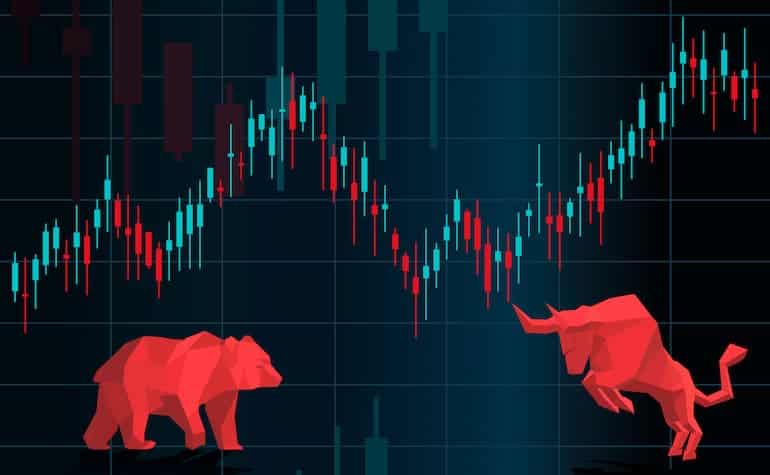

Mean reversion strategies are some of the simplest trading strategy’s used by sophisticated traders. However, when most traders hear the term, they immediately get confused. So, what is mean reversion and why do traders use it as a strategy?
Mean reversion is the tendency for the price of an asset to move back to its long-term average or mean after explosive moves to the up or downside. Traders can therefor capitalise on the end of these explosive moves by going long when the price has broken down and will revert up to the mean or short when there has been a strong move to the upside and the price will fall back to the mean. This strategy is often compared to trend following strategies in which the price tends to moving solely in one direction over a significant period with traders entering at the lows and exiting at the highs.
Mean reversion strategies can actually be used conjunction with a trend following strategy as trend following strategies will often pullback to the long-term mean. What is the mean? The mean is quite simply the average of a price over a time period.
In trading, the average can often be shown by using a moving average of mid points of ranging price. For instance, on a long term a significant average that is seen as the mean is the 200-period moving average. The 200-period moving average is used so often because of its length.
It provides an average over a significant period of time. Other averages that are often used include the 50 Period moving average and 100 period moving average. All three can be used in different ways to measure different reversions to the mean.
On a shorter timeframe, the Volume Weighted Average Price of VWAP is often used as a short-term measure of the mean as it adjust the price for the volume traded as well. What is the premise behind the strategy? The idea behind the strategy comes from the basic principles of supply and demand.
The price of an asset adjusts up and down until the there is a point of equilibrium or where the buyers and sellers reach a stalemate which then becomes the mean. Economic principals say that over time at some stage this phenomenon must occur. Therefore, even if the price of an asset or exploded, at some stage it will have to revert to the mean.
In addition, this process will occur regardless of the time frame. Over longer time frames, the process will still occur, although it may take much longer. For instance, if looking at the daily/weekly time frame, the process may take days and weeks to eventuate.
The examples below show how a simple mean reversion strategy can bring about large potential gains. Whilst this strategy can be extremely profitable it can also be risky because it can contradict some of the psychology that trading is built on especially in the short term. The mean reversion strategy requires the market to price assets based purely on the long-term supply and demand and markets do not always act rationally.
Emotions such as fear, and anxiety rule the market which lead to price action that can put pressure on these types of strategies. On both examples, after significant price movements towards the upside and downside, the prices peaked or bottomed and then returned to their long term mean indicated by the blue 200 period average.. Utilising a mean reversion strategy can provide high return opportunities for traders who can master the skill and strategy.

